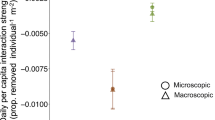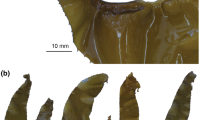Abstract
Damage by small herbivores can have disproportionately large effects on the fitness of individual plants if damage is concentrated on valuable tissues or on select individuals within a population. In marine systems, the impact of tissue loss on the growth rates of habitat-forming algae is poorly understood. We quantified the grazing damage by an isopod Amphoroidea typa on two species of large kelps, Lessonia spicata and Macrocystis pyrifera, in temperate Chile to test whether non-lethal grazing damage could reduce kelp growth rates and photosynthetic efficiency. For L. spicata, grazing damage was widespread in the field, unevenly distributed on several spatial scales (among individuals and among tissue types) and negatively correlated with blade growth rates. In field experiments, feeding by A. typa reduced the concentration of photosynthetic pigments and led to large reductions (~80 %) in blade growth rates despite limited loss of kelp biomass (0.5 % per day). For M. pyrifera, rates of damage in the field were lower and high densities of grazers were unable to reduce growth rates in field experiments. These results demonstrate that even low per capita grazing rates can result in large reductions in the growth of a kelp, due the spatial clustering of herbivores in the field and the selective removal of photosynthetically active tissues. The impacts of small herbivores on plant performance are thus not easily predicted from consumption rates or abundance in the field, and vary with plant species due to variation in their ability to compensate for damage.






Similar content being viewed by others
References
Anderson MJ, Gorley RN, Clark KR (2006) PERMANOVA+ for PRIMER: guide to software and statistical methods
Black R (1976) The effects of grazing by the limpet, Acmaea insessa, on the kelp, Egregia laevigata, in the intertidal zone. Ecology 57:265–277
Boege K, Marquis RJ (2005) Facing herbivory as you grow up: the ontogeny of resistance in plants. Trends Ecol Evol 20:441–448
Brawley SH (1992) Mesoherbivores. In: John DM, Hawkins SJ, Price JH (eds) Plant–animal interactions in the marine benthos. Clarendon, Oxford, pp 235–263
Campbell AH, Vergés A, Steinberg PD (2013) Demographic consequences of disease in a habitat-forming seaweed and impacts on interactions between natural enemies. Ecology http://dx.doi.org/10.1890/13-0213.1
Cerda O, Karsten U, Rothäusler E, Tala F, Thiel M (2009) Compensatory growth of the kelp Macrocystis integrifolia (Phaeophyceae, Laminariales) against grazing of Peramphithoe femorata (Amphipoda, Ampithoidae) in northern-central Chile. J Exp Mar Biol Ecol 377:61–67
Chess JR (1993) Effects of the stipe-boring amphipod Peramphithoe stypotrupetes (Corophioidea: Ampithoidae) and grazing gastropods on the kelp Laminaria setchelli. J Crustac Biol 13:638–646
Cook K, Vanderklift MA, Poore AGB (2011) Strong effects of herbivorous amphipods on epiphyte biomass in a temperate seagrass meadow. Mar Ecol Prog Ser 442:263–269
Crawley MJ (1985) Reduction of oak fecundity by low-density herbivore populations. Nature 314:163–164
Cyr H, Pace ML (1993) Magnitude and patterns of herbivory in aquatic and terrestrial ecosystems. Nature 361:148–150
Davenport AC, Anderson TW (2007) Positive indirect effects of reef fishes on kelp performance: the importance of mesograzers. Ecology 88:1548–1561
de Bettignies T, Thomsen MS, Wernberg T (2012) Wounded kelps: patterns and susceptibility to breakage. AquatiBiol 17:223–233
Dean TA, Schroeter SC, Dixon JD (1984) Effects of grazing by two species of sea urchins (Strongylocentrotus franciscanus and Lytechinus anamesus) on recruitment and survival of two species of kelp (Macrocystis pyrifera and Pterygophora californica). Mar Biol 78:301–313
Doak DF (1992) Lifetime impacts of herbivory for a perennial plant. Ecology 73:2086–2099
Duffy JE, Hay ME (2000) Strong impacts of grazing amphipods on the organization of a benthic community. Ecol Monogr 70:237–263
Duffy JE, Richardson JP, France KE (2005) Ecosystem consequences of diversity depend on food chain length in estuarine vegetation. Ecol Lett 8:301–309
Duggins D, Eckman JE, Siddon CE, Klinger T (2001) Interactive roles of mesograzers and current flow in survival of kelps. Mar Ecol Prog Ser 223:143–155
Gómez I, Ulloa N, Orostegui M (2005) Morpho-functional patterns of photosynthesis and UV sensitivity in the kelp Lessonia nigrescens (Laminariales, Phaeophyta). Mar Biol 148:231–240
González A, Beltrán J, Hiriart-Bertrand L, Flores V, de Reviers B, Correa JA, Santelices B (2012) Identification of cryptic species in the Lessonia nigrescens complex (Phaeophyceae, Laminariales). J Phycol 48:1153–1165
Graham MH (2002) Prolonged reproductive consequences of short-term biomass loss in seaweeds. Mar Biol 140:901–911
Graham MH, Vásquez JA, Buschmann AH (2007) Global ecology of the giant kelp Macrocystis: from ecotypes to ecosystems. Oceanogr Mar Biol Annu Rev 45:39–88
Gutow L, Long JD, Cerda O, Hinojosa IA, Rothäusler E, Tala F, Thiel M (2011) Herbivorous amphipods inhabit protective microhabitats within thalli of giant kelp Macrocystis pyrifera. Mar Biol 159:141–149
Hammons DL, Kurtural SK, Newman MC, Potter DA (2009) Invasive Japanese beetles facilitate aggregation and injury by a native scarab pest of ripening fruits. Proc Natl Acad Sci USA 106:3686–3691
Hay KB, Poore AGB, Lovelock CE (2011) Tolerance to herbivory in a brown seaweed and the effects of nutrient availability. J Ecol 99:1540–1550
Henley WJ, Dunton KH (1995) A seasonal comparison of carbon, nitrogen, and pigment content in Laminaria solidungula and L. saccharina (Phaeophyta) in the Alaskan Arctic. J Phycol 31:325–331
Henríquez LA, Buschmann AH, Maldonado MA, Graham MH, Hernández-González MC, Pereda SV, Bobadilla MI (2011) Grazing on giant kelp microscopic phases and the recruitment success of annual populations of Macrocystis pyrifera (Laminariales, Phaeophyta) in southern Chile. J Phycol 47:252–258
Hinojosa E, González P, Ugalde P, Valdivia N, Macaya E, Thiel M (2007) Distribución y abundancia de macroalgas flotando a la deriva y su fauna peracárida asociada en los canales de la XI región. Chile, Ciencia y Technologia del Mar 30
Inskeep WP, Bloom PR (1985) Extinction coefficients of chlorophyll a and b in N, N-dimethyl-formamide and 80 % acetone. Plant Physiol 77:483–485
Johnson CR, Mann KH (1986) The importance of plant defence abilities to the structure of subtidal seaweed communities: the kelp Laminaria longicruris de la Pylaie survives grazing by the snail Lacuna vincta (Montagu) at high population densities. J Exp Mar Biol Ecol 97:231–267
Krebs CJ (1999) Ecological methodology, 2nd edn. Benjamin/Cummings, Menlo Park
Krumhansl KA, Scheibling RE (2011) Spatial and temporal variation in grazing damage by the gastropod Lacuna vincta in Nova Scotian kelp beds. Aquat Biol 13:163–173
Krumhansl KA, Scheibling RE (2012) Production and fate of kelp detritus. Mar Ecol Prog Ser 467:281–302
Krupnick GA, Weis AE (1999) The effect of floral herbivory on male and female reproductive success in Isomeris arborea. Ecology 80:135–149
Lewis LS, Anderson TW (2012) Top-down control of epifauna by fishes enhances seagrass production. Ecology 93:2746–2757
Marquis RJ (1996) Plant architecture, sectoriality and plant tolerance to herbivores. Vegetation 127:85–97
Molis M, Enge A, Karsten U (2010) Grazing impact of, and indirect interactions between mesograzers associated with kelp (Laminaria digitata). J Phycol 46:76–84
Morris WF, Hufbauer RA, Agrawal AA, Bever JD, Borowicz VA, Gilbert GS, Maron JL, Mitchell CE, Parker IM, Power AG, Torchin ME, Vázquez DP (2007) Direct and interactive effects of enemies and mutualists on plant performance: a meta-analysis. Ecology 88:1021–1029
Muñoz M, Santelices B (1989) Determination of the distribution and abundance of the limpet Scurria scurra on the stipes of the kelp Lessonia nigrescens in Central Chile. Mar Ecol Prog Ser 54:277–285
Newcombe EM, Taylor RB (2010) Trophic cascade in a seaweed-epifauna-fish food chain. Mar Ecol Prog Ser 408:161–167
Pansch C, Gómez I, Rothäusler E, Véliz K, Thiel M (2008) Species-specific defences strategies of vegetative versus reproductive blades of the Pacific kelps Lessonia nigrescens and Macrocystis integrifolia. Mar Biol 155:51–52
Pavia H, Toth G, Åberg P (2002) Optimal defense theory: elasticity analysis as a tool to predict intraplant variation in defenses. Ecology 83:891–897
Pérez-Matus A, Shima JS (2010) Density- and trait-mediated effects of fish predators on amphipod grazers: potential indirect benefits for the giant kelp Macrocystis pyrifera. Mar Ecol Prog Ser 417:151–158
Poore AGB (1994) Selective herbivory by amphipods inhabiting the brown alga Zonaria angustata. Mar Ecol Prog Ser 107:113–122
Poore AGB, Campbell AH, Steinberg PD (2009) Natural densities of mesograzers fail to limit the growth of macroalgae or their epiphytes in a temperate algal bed. J Ecol 97:164–175
Poore AGB, Campbell AH, Coleman RA, Edgar GJ, Jormalainen V, Reynolds PL, Sotka EE, Stachowicz JJ, Taylor RB, Vanderklift MA, Duffy JE (2012) Global patterns in the impact of marine herbivores on benthic primary producers. Ecol Lett 15:912–922
Prado P, Collier CJ, Romero J, Alcoverro T (2011) Distinctive types of leaf tissue damage influence nutrient supply to growing tissues within seagrass shoots. Mar Biol 158:1473–1482
Puentes A, Ågren J (2012) Additive and non-additive effects of simulated leaf and inflorescence damage on survival, growth and reproduction of the perennial herb Arabidopsis lyrata. Oecologia 169:1033–1042
Rothäusler E, Thiel M (2006) Effect of detachment on the palatability of two kelp species. J Appl Phycol 18:423–435
Sala E, Graham MH (2002) Community-wide distribution of predator-prey interactions strength in kelp forests. Proc Natl Acad Sci USA 99:3683–3768
Santelices B, Castilla JC, Cancino J, Schmiede P (1980) Comparative ecology of Lessonia nigrescens and Durvillaea antarctica (Phaeophyta) in Central Chile. Mar Biol 59:119–132
Steinberg PD (1995) Interaction between the canopy dwelling echinoid Holopneustes purpurescens and its host kelp Ecklonia radiata. Mar Ecol Prog Ser 127:169–181
Steneck RS, Graham MH, Borque BJ, Corbett D, Erlandson JM, Estes JA, Tegner MJ (2002) Kelp forest ecosystems: biodiversity, stability, resilience and future. Environ Conserv 29:436–459
Stout MJ, Thaler JS, Thomma BP (2006) Plant-mediated interactions between pathogenic microorganisms and herbivorous arthropods. Annu Rev Entomol 51:663–689
Stowe KA, Marquis RJ, Hochwender CG, Simms EL (2000) The evolutionary ecology of tolerance to consumer damage. Annu Rev Ecol Syst 565–595
Strauss SY, Agrawal AA (1999) The ecology and evolution of plant tolerance to herbivory. Trends Ecol Evol 14:179–185
Tala F, Edding M (2005) Growth and loss of distal tissue in blades of Lessonia nigrescens and Lessonia trabeculata (Laminariales). Aquat Bot 82:39–54
Tala F, Edding M, Vásquez JA (2004) Aspects of the reproductive phenology of Lessonia trabeculata (Laminariales: Phaeophyceae) from three populations in northern Chile. NZ J Mar Freshwat Res 38:255–266
Tegner MJ, Dayton PK (1987) El Niño effects on southern California kelp forest communities. Adv Ecol Res 17:243–279
Thiel M, Vásquez JA (2000) Are kelp holdfasts islands on the ocean floor?-indication for temporarily closed aggregations of peracarid crustaceans. Hydrobiologia 440:45–54
Tiffin P (2000) Mechanisms of tolerance to herbivore damage: what do we know? Evol Ecol 14:523–536
Toth G, Pavia H (2007) Induced herbivore resistance in seaweeds: a meta-analysis. J Ecol 95:425–434
Toth G, Karlsson M, Pavia H (2007) Mesoherbivores reduce net growth and induce chemical resistance in natural seaweed populations. Oecologia 152:245–255
Underwood N, Anderson K, Inouye BD (2005) Induced vs. constitutive resistance and the spatial distribution of insect herbivores among plants. Ecology 86:594–602
Uthicke S, Schaffelke B, Byrne M (2009) A boom–bust phylum? Ecological and evolutionary consequences of density variations in echinoderms. Ecol Monogr 79:3–24
Vásquez JA (2008) Production, use and fate of Chilean brown seaweeds: re-sources for a sustainable fishery. J Appl Phycol 20:457–467
Vergés A, Pérez M, Alcoverro T, Romero J (2008) Compensation and resistance to herbivory in seagrasses: induced responses to simulated consumption by fish. Oecologia 155:751–760
Whalen MA, Duffy JE, Grace JB (2013) Temporal shifts in top-down vs. bottom-up control of epiphytic algae in a seagrass ecosystem. Ecology 94:510–520
Acknowledgments
We thank L. Jorquera, L. Miranda and G. Penna for assistance with field and laboratory work, A. Letten for assistance with analyses and J. Shurin and two anonymous reviewers for comments that improved this manuscript. Research was supported by FONDECYT grant 1100749 to M.T. and BMBF-CONICYT grant 01DN12106 to M.T. and L.G.
Author information
Authors and Affiliations
Corresponding author
Additional information
Communicated by Jonathan Shurin.
Electronic supplementary material
Below is the link to the electronic supplementary material.
Rights and permissions
About this article
Cite this article
Poore, A.G.B., Gutow, L., F. Pantoja, J. et al. Major consequences of minor damage: impacts of small grazers on fast-growing kelps. Oecologia 174, 789–801 (2014). https://doi.org/10.1007/s00442-013-2795-4
Received:
Accepted:
Published:
Issue Date:
DOI: https://doi.org/10.1007/s00442-013-2795-4




